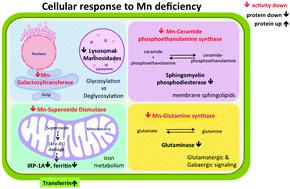当前位置:
X-MOL 学术
›
Metallomics
›
论文详情
Our official English website, www.x-mol.net, welcomes your
feedback! (Note: you will need to create a separate account there.)
Intestinal response to dietary manganese depletion in Drosophila.
Metallomics ( IF 2.9 ) Pub Date : 2019-11-26 , DOI: 10.1039/c9mt00218a Johana Vásquez-Procopio 1 , Beatriz Osorio , Leticia Cortés-Martínez , Fidel Hernández-Hernández , Oscar Medina-Contreras , Emmanuel Ríos-Castro , Aram Comjean , Fangge Li , Yanhui Hu , Stephanie Mohr , Norbert Perrimon , Fanis Missirlis
Metallomics ( IF 2.9 ) Pub Date : 2019-11-26 , DOI: 10.1039/c9mt00218a Johana Vásquez-Procopio 1 , Beatriz Osorio , Leticia Cortés-Martínez , Fidel Hernández-Hernández , Oscar Medina-Contreras , Emmanuel Ríos-Castro , Aram Comjean , Fangge Li , Yanhui Hu , Stephanie Mohr , Norbert Perrimon , Fanis Missirlis
Affiliation

|
Manganese is considered essential for animal growth. Manganese ions serve as cofactors to three mitochondrial enzymes: superoxide dismutase (Sod2), arginase and glutamine synthase, and to glycosyltransferases residing in the Golgi. In Drosophila melanogaster, manganese has also been implicated in the formation of ceramide phosphoethanolamine, the insect's sphingomyelin analogue, a structural component of cellular membranes. Manganese overload leads to neurodegeneration and toxicity in both humans and Drosophila. Here, we report specific absorption and accumulation of manganese during the first week of adulthood in flies, which correlates with an increase in Sod2 activity during the same period. To test the requirement of dietary manganese for this accumulation, we generated a Drosophila model of manganese deficiency. Due to the lack of manganese-specific chelators, we used chemically defined media to grow the flies and deplete them of the metal. Dietary manganese depletion reduced Sod2 activity. We then examined gene and protein expression changes in the intestines of manganese depleted flies. We found adaptive responses to the presumed loss of known manganese-dependent enzymatic activities: less glutamine synthase activity (amination of glutamate to glutamine) was compensated by 50% reduction in glutaminase (deamination of glutamine to glutamate); less glycosyltransferase activity, predicted to reduce protein glycosylation, was compensated by 30% reduction in lysosomal mannosidases (protein deglycosylating enzymes); less ceramide phosphoethanolamine synthase activity was compensated by 30% reduction in the Drosophila sphingomyeline phospodiesterase, which could catabolize ceramide phosphoethanolamine in flies. Reduced Sod2 activity, predicted to cause superoxide-dependent iron–sulphur cluster damage, resulted in cellular iron misregulation.
中文翻译:

果蝇中膳食锰消耗的肠道反应。
锰被认为对动物生长至关重要。锰离子可作为三种线粒体酶的辅助因子:超氧化物歧化酶(Sod2),精氨酸酶和谷氨酰胺合酶,以及高尔基体中的糖基转移酶。在果蝇中,锰也参与了神经酰胺磷酸乙醇胺的形成,神经酰胺磷酸乙醇胺是昆虫的鞘磷脂类似物,是细胞膜的一种结构成分。锰超载会导致人类和果蝇神经变性和毒性。在这里,我们报告果蝇成年后第一周锰的特定吸收和积累,这与同期Sod2活性的增加有关。为了测试膳食锰对这种积累的需求,我们生成了一个果蝇锰缺乏模型。由于缺乏特定于锰的螯合剂,我们使用化学成分确定的培养基来培育果蝇并消耗其中的金属。饮食中的锰消耗降低了Sod2活性。然后,我们检查了贫锰果蝇肠道中基因和蛋白质表达的变化。我们发现了对已知的锰依赖性酶活性的预期损失的适应性反应:谷氨酰胺酶减少(谷氨酰胺脱氨为谷氨酸)补偿了较少的谷氨酰胺合酶活性(将谷氨酸氨基化为谷氨酰胺);溶酶体甘露糖苷酶(蛋白质去糖基化酶)减少了30%,从而弥补了预计减少蛋白质糖基化作用的较少的糖基转移酶活性;较少的神经酰胺磷酸乙醇胺合酶活性可以通过降低30%果蝇鞘氨醇磷酸二酯酶,可分解果蝇中的神经酰胺磷酸乙醇胺。降低的Sod2活性预计会导致超氧化物依赖性铁硫簇的破坏,从而导致细胞铁的调节异常。
更新日期:2019-11-26
中文翻译:

果蝇中膳食锰消耗的肠道反应。
锰被认为对动物生长至关重要。锰离子可作为三种线粒体酶的辅助因子:超氧化物歧化酶(Sod2),精氨酸酶和谷氨酰胺合酶,以及高尔基体中的糖基转移酶。在果蝇中,锰也参与了神经酰胺磷酸乙醇胺的形成,神经酰胺磷酸乙醇胺是昆虫的鞘磷脂类似物,是细胞膜的一种结构成分。锰超载会导致人类和果蝇神经变性和毒性。在这里,我们报告果蝇成年后第一周锰的特定吸收和积累,这与同期Sod2活性的增加有关。为了测试膳食锰对这种积累的需求,我们生成了一个果蝇锰缺乏模型。由于缺乏特定于锰的螯合剂,我们使用化学成分确定的培养基来培育果蝇并消耗其中的金属。饮食中的锰消耗降低了Sod2活性。然后,我们检查了贫锰果蝇肠道中基因和蛋白质表达的变化。我们发现了对已知的锰依赖性酶活性的预期损失的适应性反应:谷氨酰胺酶减少(谷氨酰胺脱氨为谷氨酸)补偿了较少的谷氨酰胺合酶活性(将谷氨酸氨基化为谷氨酰胺);溶酶体甘露糖苷酶(蛋白质去糖基化酶)减少了30%,从而弥补了预计减少蛋白质糖基化作用的较少的糖基转移酶活性;较少的神经酰胺磷酸乙醇胺合酶活性可以通过降低30%果蝇鞘氨醇磷酸二酯酶,可分解果蝇中的神经酰胺磷酸乙醇胺。降低的Sod2活性预计会导致超氧化物依赖性铁硫簇的破坏,从而导致细胞铁的调节异常。











































 京公网安备 11010802027423号
京公网安备 11010802027423号